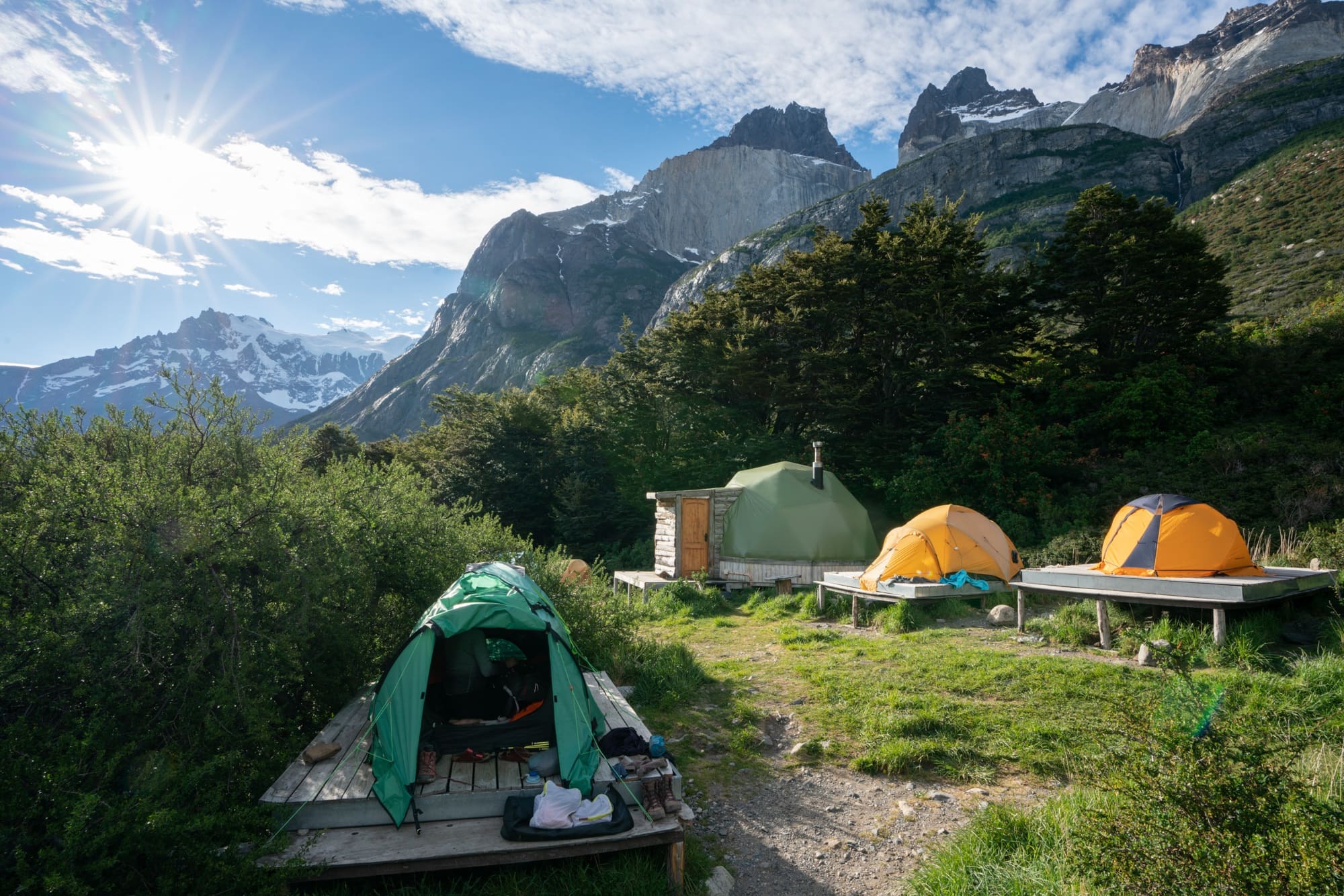Assuming you have your hiking gear and clothes sorted, here are some extra items to consider packing for the W Trek in Patagonia:
-A headlamp or flashlight
-Sunscreen and lip balm
-Bug spray
-Bear horn or pepper spray (if camping)
-First aid kit including supplies for blisters and any medications you take regularly
-Toiletries including toilet paper, wipes, hand sanitizer, etc.
-Snacks and energy bars
-Plenty of water (at least 2 liters per day)
Wondering what to pack for your W Trek in Patagonia? Here are a few essential items:
-Hiking boots: You’ll want a good pair of hiking boots to tackle the W Trek.
Make sure they’re comfortable and broken in before you go.
-Rain gear: Patagonia is known for its unpredictable weather, so be prepared with rain gear. A waterproof jacket and pants are essential.
-Thermal layers: Even in the summer, nights can be chilly in Patagonia. Bring along some thermal layers to keep warm.
-Sun protection: The sun can be intense at high altitudes, so don’t forget to pack sunscreen, sunglasses, and a hat.
W Trek Backpack Size
Walking the W Trek in Torres del Paine National Park is an amazing experience. The scenery is unrivaled, and the sense of accomplishment you feel upon completing the trek is unbeatable. But before you set off on your journey, it’s important to make sure you have all the necessary gear.
In this blog post, we’ll help you determine what size backpack you need for the W Trek.
The W Trek is a multi-day hike that covers approximately 55km (34 miles). Most people complete the trek in 4-5 days, although it can be done in as few as 3 days if you’re willing to push yourself.
Regardless of how long it takes you to complete the hike, you’ll need a backpack that can comfortably carry all your gear.
Most people opt for a 40-60L backpack for the W Trek. This size backpack will give you enough room to pack everything you need without being too cumbersome to carry.
If you’re planning on carrying your own food and camping gear,you may want to size up to a 60L backpack. But if you’re comfortable with using the huts along the trail and carrying only essential items, a 40L backpack should suffice.
No matter what size backpack you choose, be sure to break it in before your hike by taking it on some day hikes or extended walks around town.
This will help prevent any discomfort or soreness on your trek. And finally, don’t forget to pack plenty of water and snacks!
O Trek Patagonia Packing List
One of the most important things to consider when packing for a trek in Patagonia is the weather. The region experiences extreme changes in temperature, so it’s important to pack accordingly. Here are some items to consider bringing on your trek:
– Thermal underwear: layers are key in Patagonia. You’ll want to have a good pair of thermal underwear to keep you warm at night.
– Fleece: a fleece or other synthetic insulation layer is essential for cold days and nights.
– Down jacket: a down jacket should be your go-to outer layer when it’s cold out. Make sure it’s waterproof and windproof!
– Hiking boots: comfortable, broken-in hiking boots are a must.
Choose something with good traction for wet and icy conditions.
– Trekking poles: these can be helpful on steep or slippery sections of trail.
Swoop Patagonia Packing List
When packing for a trip to Patagonia, it’s important to be prepared for all kinds of weather conditions. Here is a suggested packing list for a comfortable and safe trip:
-Sturdy shoes or boots with good traction, suitable for hiking
-Warm layers including a waterproof outer layer
-Hat, scarf, and gloves
-Sunscreen and sunglasses
-First Aid kit including supplies for blisters, insect bites, and diarrhea
-Water bottle
-Snacks
-Camera!
Food for W Trek
If you’re planning on trekking the W in Patagonia, you’ll need to make sure you have enough food to keep you going. Here are some things to consider when packing your food for the trip:
1. How much food will you need?
This will depend on how long your trek is, how many people you are feeding, and how much each person usually eats. Make sure to pack enough for leftovers just in case.
2. What kind of foods will be easy to carry and won’t weigh you down?
Non-perishable items like granola bars, dried fruit, nuts, and crackers are all good options. You can also bring along some fresh fruit and vegetables if they won’t add too much weight to your pack.
3. What can you cook while on the trail?
If you’re camping out overnight, you may want to bring along a portable stove so you can cook up some hot meals. Otherwise, instant oatmeal or ramen noodles can be easily prepared with just a little boiling water.
4. Don’t forget the snacks!
It’s always good to have something handy to munch on when energy levels start flagging mid-hike.
W Trek in Summer
One of the most popular treks in Torres del Paine National Park is the W Trek. The W trek gets its name from the shape of the route, which resembles a “W”. This trek can be done in 5-7 days and takes you through some of the most iconic scenery in the park including views of the Towers, Grey Glacier and French Valley.
The best time to do this trek is during summer (November-February) when weather conditions are more stable.

Credit: bearfoottheory.com
How Do I Prepare for Patagonia W Trek?
If you’re planning on trekking through Patagonia, you’ll want to make sure you’re properly prepared. Here are a few tips on how to get ready for your journey:
1. Choose the right gear.
You’ll need sturdy walking shoes or boots, comfortable clothing that can layer, and a good rain jacket. Be sure to pack plenty of socks and underwear as well!
2. Get in shape.
This is not a hike for beginners! Make sure you’re physically fit before attempting the journey. Start by adding some extra hikes into your routine leading up to the trip.
3. Plan your route. There are many different ways to trek through Patagonia – be sure to do your research and pick the route that’s right for you and your group’s abilities. Once you’ve decided on a route, map it out and familiarize yourself with the area.
4. Pack food and water wisely .You’ll need to bring enough food and water to last throughout the entire trek, as there will likely be no place to resupply along the way. dehydrated meals, snacks high in protein and carbohydrates, and packed nuts are all great options for easy-to-carry foods that will give you energy during your hike .
As for water, consider bringing along a filtration system so you can purify any water found along the way – this way, you won’t have to carry as much with you from the start .
5Acclimate yourself if coming from lower altitudes . If Patagonia is significantly higher than where you live , it’s important give yourself time to adjust before starting your hike .
This means slowly increasing activity levels over several days while also staying hydrated .
How Difficult is the W Trek in Patagonia?
The W trek in Patagonia is one of the most popular treks in the world. It is a challenging trek that takes you through some of the most beautiful scenery in Patagonia. The trek is not for the faint-hearted and requires a good level of fitness.
However, if you are up for the challenge, it is an unforgettable experience. Here are some things to consider before embarking on the W Trek:
1. The W Trek is a demanding hike and should only be attempted by those who are fit and have previous hiking experience.
If you are not used to hiking, or if you have any medical conditions that could be exacerbated by strenuous exercise, it is best to consult with your doctor before undertaking this trek.
2. The W Trek takes place in remote areas of Patagonia and there is no cell phone reception or internet access along the way. Make sure you are prepared mentally and emotionally for being cut off from communication with the outside world for several days.
3. The weather in Patagonia can be extreme, with high winds and freezing temperatures common even during summer months (December-February). Be sure to pack appropriate clothing and gear, including warm layers, rain gear, sunscreen, hats, gloves, etc.
4. Although the scenery on the W Trek is absolutely stunning, there will be times when you will be pushing yourself physically and mentally to keep going.
Be prepared for long days of hiking and tough conditions at times – but know that it will all be worth it in the end!
Do I Need Hiking Boots for the W Trek?
Hiking boots are not strictly necessary for the W trek, but they are recommended. The W trek is a challenging hike, with some difficult sections. Having a good pair of hiking boots will help you to feel more comfortable and confident on the trail.
Additionally, hiking boots provide good support and traction, which can be helpful on the rocky and uneven terrain of the W trek.
What Should I Pack for 2 Weeks in Patagonia?
Assuming you are travelling to Patagonia in Chile:
The first thing you need to consider when packing for a trip is the weather. Patagonia has a temperate climate, with average temperatures ranging from 10-15 degrees Celsius in the winter to 20-25 degrees Celsius in the summer.
However, it is important to pack for both extremes, as the weather can change quickly and unexpectedly. In general, you should pack light layers that can be easily added or removed as needed.
Next, consider your activities.
If you plan on doing any hiking or camping, you will need to pack accordingly. Be sure to bring plenty of water and food, as well as a map and compass (or GPS). Also pack a first aid kit, including supplies for blisters and snake bites.
If you are planning on doing any fishing, you will need to obtain a permit beforehand.
Other essential items include a valid passport (if travelling from outside of Chile), travel insurance, and enough Chilean Pesos for your stay. It is also recommended to bring along a small backpack or daypack for carrying essentials while exploring during the day.
What to Pack for The O Circuit and W Trek in Patagonia + Tips for Your Trip
Conclusion
Wondering what to pack for W Trek Patagonia? You’ve come to the right place! In this blog post, we’ll go over everything you need to pack for this amazing trekking adventure.
From clothes and footwear to essential gear, we’ve got you covered. So, let’s get started!
